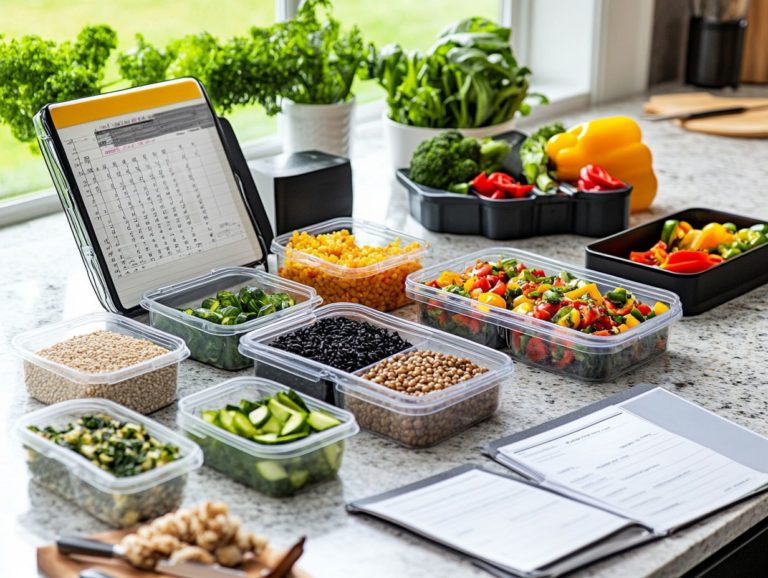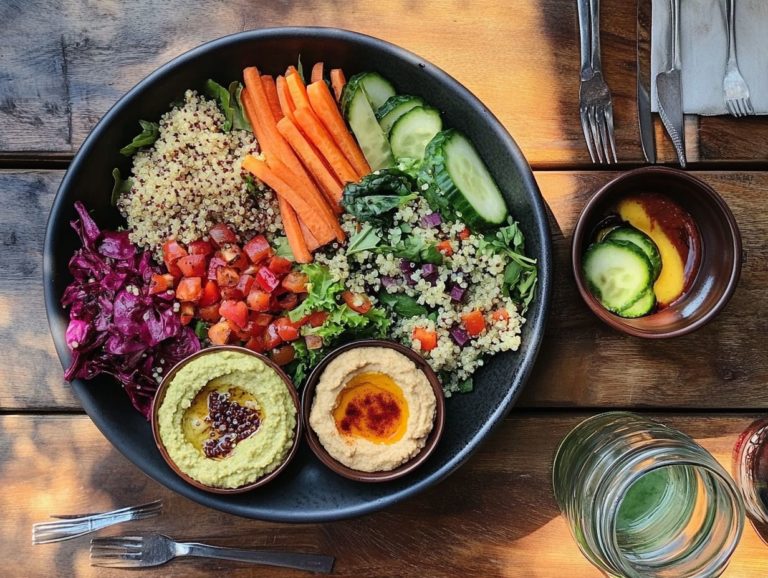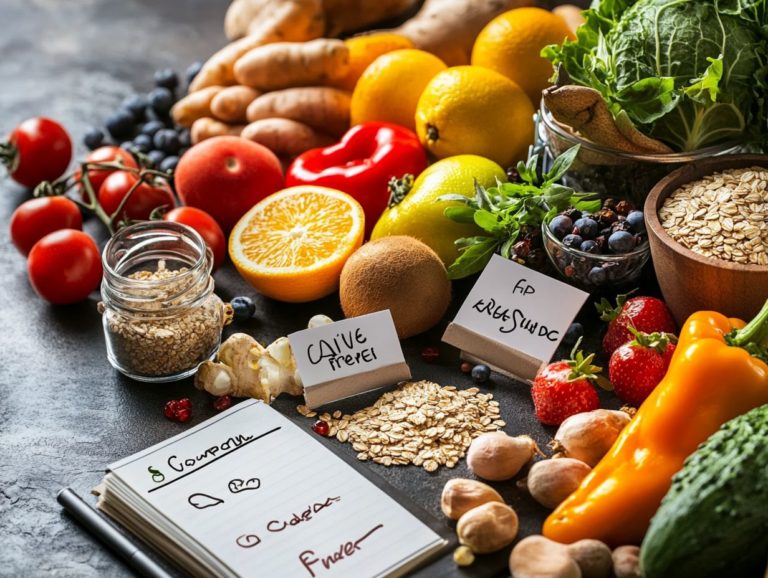10 Ingredients Every Meal Planner Should Have
Crafting the perfect meal plan may feel daunting. It doesn’t have to be! With the right ingredients at your fingertips, you can whip up delicious meals that nourish your body and delight your taste buds.
You ll explore ten essential ingredients that every meal planner should have stocked in their kitchen. These range from vibrant fruits and vegetables to lean proteins and healthy fats.
You will also discover tips on how meal planning can save you time and money, and even support your weight loss goals. Dive in and discover just how easy and enjoyable meal planning can be!
Contents
- Key Takeaways:
- 1. A Variety of Fruits and Vegetables
- 2. Lean Protein Sources
- 3. Whole Grains and Complex Carbohydrates
- 4. Healthy Fats
- 5. Herbs and Spices for Flavor
- 6. Dairy or Dairy Alternatives
- 7. Nuts and Seeds
- 8. Superfoods for Nutritional Boost
- 9. Low-Calorie Flavor Enhancers
- 10. Healthy Snack Options
- How to Create a Balanced Meal Plan?
- Frequently Asked Questions
Key Takeaways:
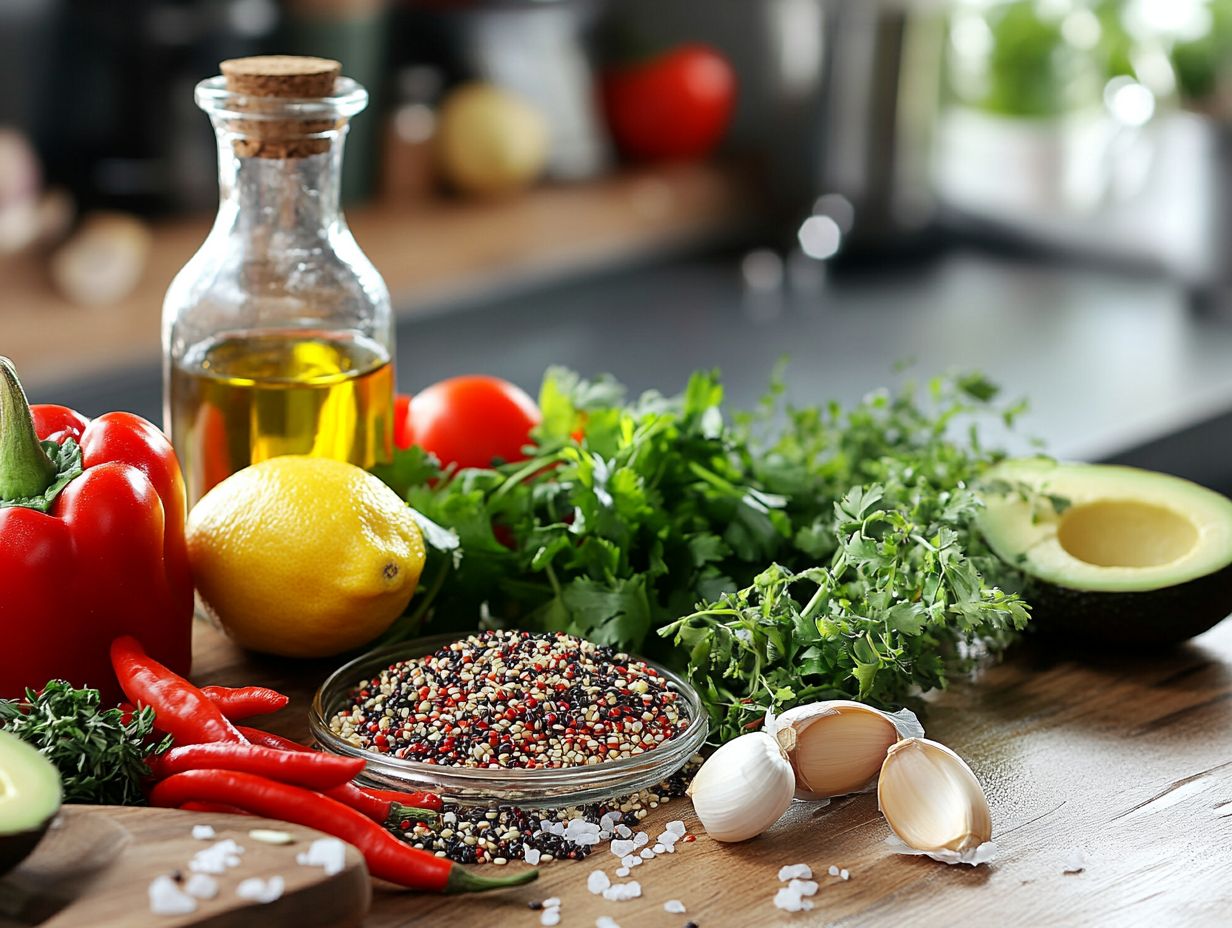
Include a variety of fruits and vegetables in your meal plan to ensure you get a range of essential vitamins and minerals.
Incorporate lean protein sources like chicken, fish, and tofu to build and maintain muscle while feeling full and satisfied.
Make sure to include whole grains and complex carbohydrates for sustained energy and to keep you feeling full longer.
1. A Variety of Fruits and Vegetables
Incorporating a variety of fruits and vegetables into your meal planning elevates the nutritional value of your meals and helps reduce food waste. This is essential for an effective grocery list and meal prep strategy that maintains a balanced diet.
When you embrace seasonal varieties, flavors come alive, and you enjoy the good stuff our bodies need at their peak freshness. These colorful options are vital in crafting nourishing meals.
Simple tips for managing food, like planning your meals around what s in season or creatively using leftovers, can cut down on waste. By integrating diverse produce into easy recipes think vibrant stir-fries or hearty salads meal prep transforms from a mundane task into an enjoyable experience, ensuring that nutritious choices are always at your fingertips.
2. Lean Protein Sources
Selecting lean protein sources is essential in your meal planning. These options deliver vital nutrients while keeping your dishes healthy and satisfying.
This opens the door to a trove of easy recipes perfect for beginners and family cooking. By incorporating a variety of options think chicken, turkey, fish, and plant-based alternatives like lentils and quinoa you significantly elevate your diet.
Each protein type has unique advantages. Fish is a powerhouse of omega-3 fatty acids, while turkey is low in fat and high in protein. Planning your meals around these proteins helps you stay energized throughout the day.
On busy weekdays, consider meal prepping:
- Grilled chicken breasts
- Baked salmon
You might also whip up stir-fries with tofu and a medley of vegetables for a quick and delicious dinner. These straightforward strategies will transform healthy eating into something manageable and delightful.
3. Whole Grains and Complex Carbohydrates
Whole grains and complex carbohydrates are essential elements of a healthy meal plan. They offer sustained energy and vital nutrients while keeping your grocery shopping aligned with your dietary aspirations.
Incorporating options like quinoa, brown rice, barley, and whole grain bread can significantly elevate your diet.
Quinoa is a complete protein, making it an outstanding choice for those on a plant-based journey, while brown rice, rich in fiber, supports digestion effectively.
Whole grain bread, brimming with B vitamins, serves as a convenient foundation for delicious, nutritious sandwiches.
Cooking these grains is straightforward. Rinsing quinoa before cooking helps eliminate its natural bitterness, and a good soak for brown rice can cut down on cooking time.
To integrate them into balanced meals, consider:
- Stir-frying vibrant vegetables over a bed of brown rice
- Tossing quinoa into salads for an extra protein boost
Prepping grains in bulk can save you precious time during the week, enabling quick assembly of wholesome lunches or dinners.
4. Healthy Fats
Incorporating healthy fats into your meals while delivering essential nutrients supports your overall health. Make sure healthy fats are a staple on your grocery list.
Healthy fats are found in foods like olive oil, avocados, and various nuts. They help keep your heart healthy, reduce inflammation, and enhance vitamin absorption.
Imagine this: a drizzle of olive oil that turns your salad into a gourmet treat! Creamy avocado on your morning toast boosts flavor and keeps you satisfied for longer.
Nuts add a satisfying crunch that pairs beautifully with both sweet and savory dishes, making them ideal for snacks or as toppings.
To seamlessly incorporate these healthy fats into your diet, consider prepping a mix of nuts for quick snacks or blending avocado into smoothies for a rich, creamy texture.
Keep your pantry organized to ensure a balanced diet. Arranging your foods by category not only guides healthier choices but also inspires creative cooking.
5. Herbs and Spices for Flavor
Herbs and spices enhance flavor and offer health benefits. They can transform simple recipes into exciting culinary creations, sparking your creativity in the kitchen.
Take basil and oregano, for example. They’re not merely staples of Italian cuisine; they also offer antioxidants that bolster your immune system. If you re just starting your culinary journey, incorporating these herbs into sauces or salad dressings is easy!
Spices like turmeric and cinnamon are powerhouses of anti-inflammatory properties. They can easily be stirred into smoothies or sprinkled over oatmeal for an instant health boost.
Meal prep becomes a delightful exploration as you experiment with various combinations of these flavoring agents, ensuring that every dish remains fresh and appealing throughout the week.
Embracing simple cooking tips, such as adding fresh herbs at the end of cooking or toasting spices before use, can elevate even the most basic meal into something truly extraordinary!
6. Dairy or Dairy Alternatives

Incorporating dairy or its alternatives into your meal planning opens the door to essential nutrients while catering to various dietary needs. This ensures your meals are both balanced and satisfying.
Explore options like low-fat yogurt and almond milk for tasty meals that align with your health goals. You can enjoy a delightful array of flavors and textures that elevate your dishes.
These options are packed with calcium and protein. Yogurt even contains beneficial probiotics! Integrating these alternatives into your breakfast smoothies, savory soups, or creamy pasta dishes is a breeze.
By stocking pantry staples such as quinoa, lentils, and seasonal vegetables, you can whip up nutritious, delicious meals whether cooking for yourself or hosting family gatherings, ensuring everyone savors a wholesome dish.
7. Nuts and Seeds
Nuts and seeds are exceptional allies in your meal planning arsenal. They offer healthy snacks while enriching your meals with impressive nutrient profiles, making them a versatile choice for a balanced diet.
By including a variety of nuts think almonds, walnuts, and cashews along with seeds like chia, flax, and pumpkin, you can vastly enhance your nutrient intake. These simple powerhouses are brimming with essential fatty acids, protein, fiber, vitamins, and minerals!
For meal prep, consider these delightful options:
- Toss a handful of nuts into your morning oatmeal or yogurt.
- Blend seeds into your smoothies for a nutritious boost.
- Sprinkle chopped nuts over salads to add a satisfying crunch.
Lightly roasting nuts with spices can elevate their flavors, transforming them into savory snacks you ll love throughout the day.
And soaking chia seeds overnight? It turns them into a delightful pudding, providing an easy, nutrient-packed option for breakfast or dessert!
8. Superfoods for Nutritional Boost
Integrar superalimentos en tu meal planning puede proporcionar beneficios significativos para la salud. Esto realmente eleva tu juego en la preparaci n de comidas, asegurando que tu familia disfrute de platos ricos en nutrientes.
Estos ingredientes poderosos, como la quinoa y el kale, est n repletos de vitaminas, minerales y antioxidantes. Esto los convierte en elecciones estelares para mejorar el bienestar general.
La quinoa, que es una fuente completa de prote nas, sirve como una base sustanciosa para tus ensaladas y salteados. El kale aporta un impulso nutricional a tus batidos y sopas.
Y no olvidemos las bayas: ofrecen una dulzura deliciosa, perfecta para tazones de desayuno o refrigerios saludables. Considera preparar grandes cantidades de quinoa y kale durante el fin de semana.
Porci nalos para almuerzos o cenas r pidas a lo largo de la semana. Ten bayas congeladas a mano para preparar batidos vibrantes o postres en cualquier momento que desees.
9. Low-Calorie Flavor Enhancers
Low-calorie flavor enhancers can completely transform your meal planning experience. They allow you to add incredible taste without compromising your health goals.
These enhancements do more than just elevate your dishes; they spark your culinary creativity. Take vinegar, for example. Its bright and zesty notes can revolutionize your salad dressings and marinades.
Mustard offers a spicy kick for sandwiches and blends easily into sauces without adding calories. A variety of spices, from cumin to paprika, can weave rich flavors in your soups and stews.
As a beginner, you can easily start by mixing vinegar with olive oil for a refreshing dressing. Season roasted vegetables with your favorite spice blend for added zing.
With these tips, you ll find that mealtime becomes healthier and infinitely more enjoyable.
10. Healthy Snack Options
Including healthy snack options in your meal planning is a smart move. They help manage hunger throughout the day, especially for those with busy schedules.
Choose snacks that are easy to prepare whether in single portions or batch-cooked. This way, you can effortlessly incorporate nutritious choices into your daily routine.
For example, prepped veggie sticks with hummus or yogurt topped with granola are delightful and require minimal effort. Whipping up larger quantities of energy bites or roasted chickpeas means you ll have quick grab-and-go nutrition.
With a bit of planning, these snack ideas can lead to lasting benefits for your overall well-being.
How to Create a Balanced Meal Plan?
Creating a balanced meal plan requires a thoughtful, step-by-step approach. Take your dietary needs into account and include a variety of food groups.
Start by assessing your individual dietary requirements. This means considering any allergies, nutritional goals, or lifestyle choices like vegetarianism or low-carb diets.
Next, choose diverse recipes that include proteins, grains, fruits, and vegetables. This will enhance variety and elevate your meal satisfaction.
Once you have your recipes, organize a comprehensive grocery list. This prevents redundancy and streamlines your shopping experience.
Meal prep tips can significantly simplify your cooking process. For example, batch cooking allows you to prepare ingredients in advance, making healthy meals readily accessible.
With these strategies in place, you ll be well on your way to enjoying nutritious and delicious meals with ease.
What Are the Benefits of Meal Planning?
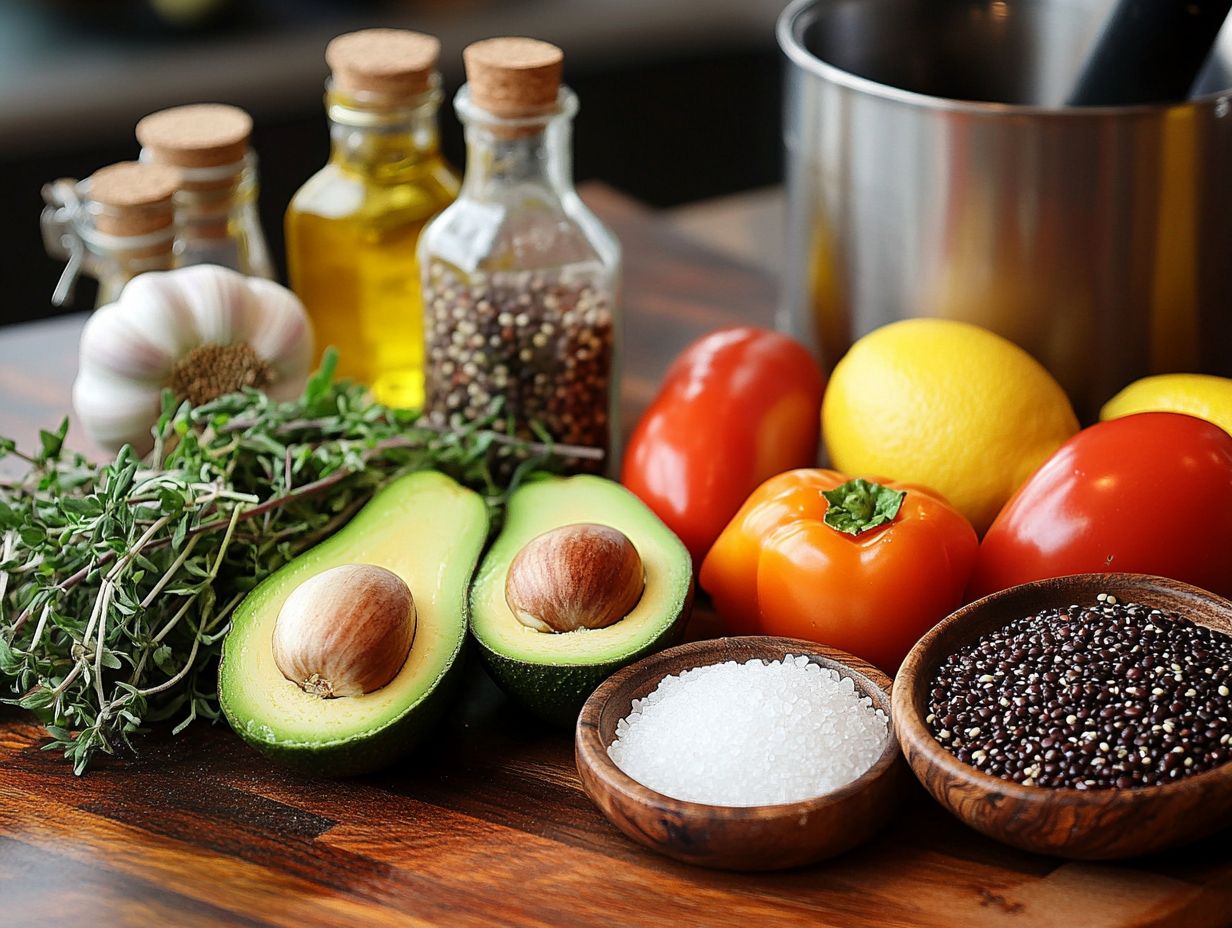
The benefits of meal planning are truly abundant. It helps you reduce food waste, optimize your grocery shopping, and make healthy meals tailored to your dietary needs.
By dedicating some time to plan your weekly meals, you’ll love how much money you can save! You’ll find yourself less likely to make impulsive purchases at the store and can use ingredients more efficiently throughout the week.
This thoughtful approach streamlines your grocery list and helps you minimize those last-minute takeout orders that can add up quickly.
With meals prepped in advance, the stress of daily cooking decisions evaporates. This paves the way for a more relaxed mealtime experience. Meal planning helps you choose healthier options, as you re more likely to opt for nutritious foods over convenient junk food when you have a clear plan guiding your choices.
How Can Meal Planning Save Time and Money?
Meal planning can truly transform your kitchen experience, saving you both time and money. By organizing your grocery shopping, you can take advantage of bulk purchasing and significantly minimize waste, helping you stick to your food budget.
When you outline your meals in advance, you can create detailed grocery lists that reflect your needs. This foresight prevents those pesky impulse buys that often inflate your expenses.
Planning allows you to batch-cook meals over the weekend, ensuring that you have nutritious options readily available during hectic weekdays.
To maximize efficiency, consider prepping ingredients ahead of time. Chop those vegetables or marinate proteins in advance. Just a little effort can make your cooking time much easier!
By employing these strategies, you ll enhance your productivity in the kitchen and cultivate a more cohesive family dynamic around shared mealtimes.
What Are Some Tips for Sticking to a Meal Plan?
Sticking to a meal plan demands discipline and effective strategies, such as well-crafted meal prep tips, inventive cooking techniques, and a flexible approach to grocery shopping.
By weaving flexibility into your meal planning process, you can navigate unexpected cravings and busy schedules without feeling deprived.
Keeping a list of diverse meal ideas on hand helps maintain variety and simplifies decision-making on hectic days.
Experimenting with different cooking techniques whether it s roasting, stir-frying, or embracing the wonders of a slow cooker can bring excitement to your daily meals. This ensures that healthy eating never feels monotonous.
Ultimately, striking a balance between structure and spontaneity will empower you to stay steadfast in your nutritional goals.
How Can Meal Planning Help with Weight Loss?
Think of meal planning as your secret weapon for losing weight! It promotes the creation of healthy, balanced meals while enhancing your food management and portion control, especially if you re cooking for one.
By planning your meals in advance, you set clear intentions that help eliminate the chaos of last-minute food choices. This thoughtful approach encourages you to choose nutritious ingredients, resulting in satisfying meals that are lower in calories and packed with essential nutrients.
With a well-structured menu at your fingertips, you re far less likely to reach for unhealthy snacks or succumb to fast food cravings. Both can derail your weight loss journey.
Ultimately, meal planning cultivates discipline, guiding you toward consistent, healthier choices while keeping your hunger in check.
What Are Some Common Mistakes to Avoid When Meal Planning?
Meal planning mistakes can waste food and create poor grocery lists. Thoughtful preparation and a bit of flexibility are key.
It s easy to feel overwhelmed by complex recipes. This often leads to committing to dishes that don t fit your schedule.
If you forget about leftovers, you might end up with wasted food. A flexible meal plan helps you adjust for variations and substitutions.
Keep an adaptable grocery list to accommodate changes in preferences or unexpected events. This ensures every ingredient has a purpose and reduces waste.
Frequently Asked Questions
What are the 10 essential ingredients every meal planner should have?
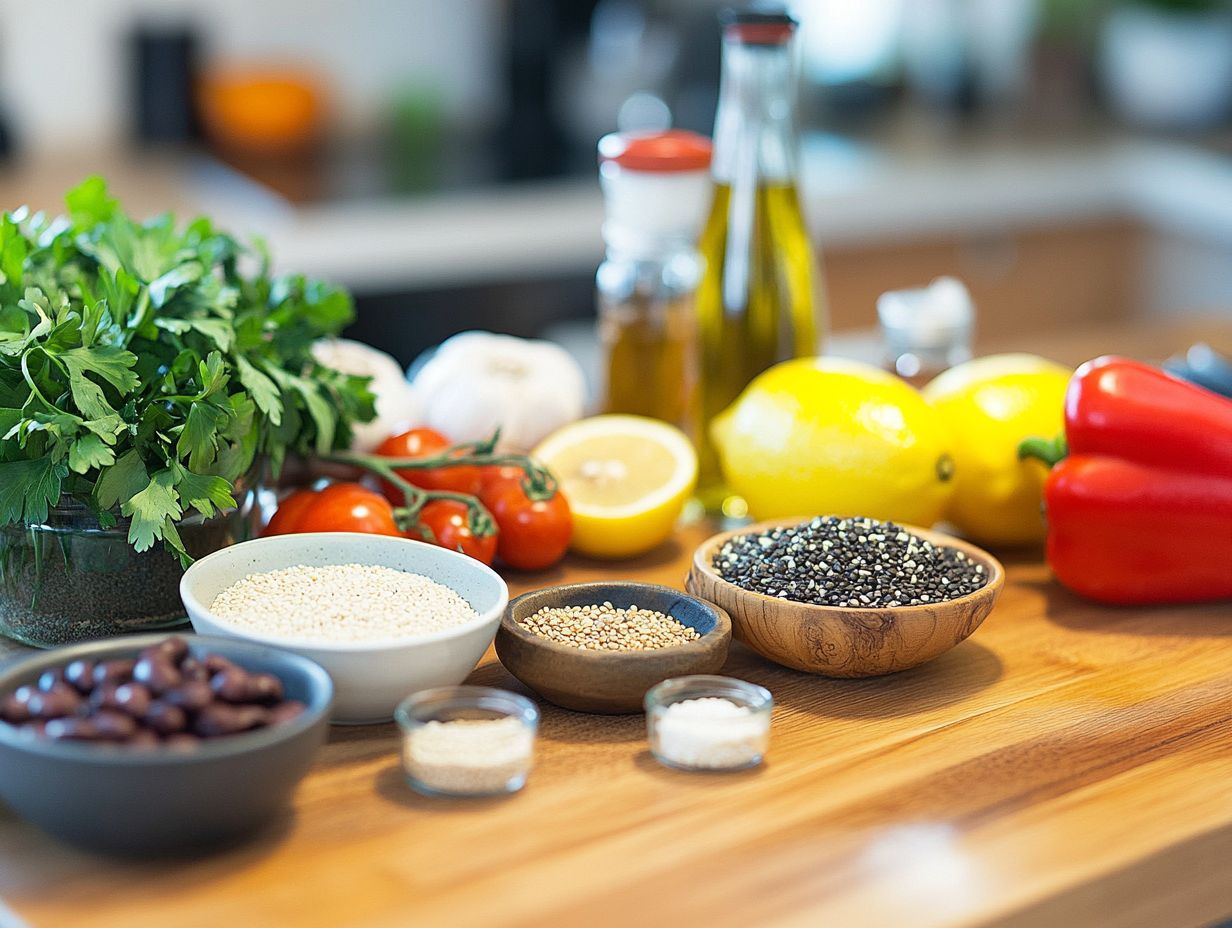
Every meal planner should have protein (meat or plant-based), whole grains, vegetables, fruit, healthy fats, herbs and spices, condiments, broth or stock, canned goods, and frozen items.
Why is protein important for meal planning?
Protein helps build and repair body tissues. It also keeps you feeling full, making it essential for planning meals.
What are examples of healthy fats to include?
Healthy fats like avocado, olive oil, nuts, and seeds provide energy and help absorb vitamins. Don’t forget to add these to your shopping list!
Are canned goods healthy for meal planning?
Yes! Canned goods like beans, tomatoes, and tuna are convenient and healthy. Just choose low-sodium options without added sugars.
Why include frozen items in meal planning?
Frozen fruits and vegetables are often just as nutritious as fresh ones. They last longer, giving you a variety of ingredients for meal planning.
Are condiments necessary for meal planning?
Condiments may not seem crucial, but they add flavor and variety to your meals. Look for healthier options like mustard and salsa, and use them in moderation!

